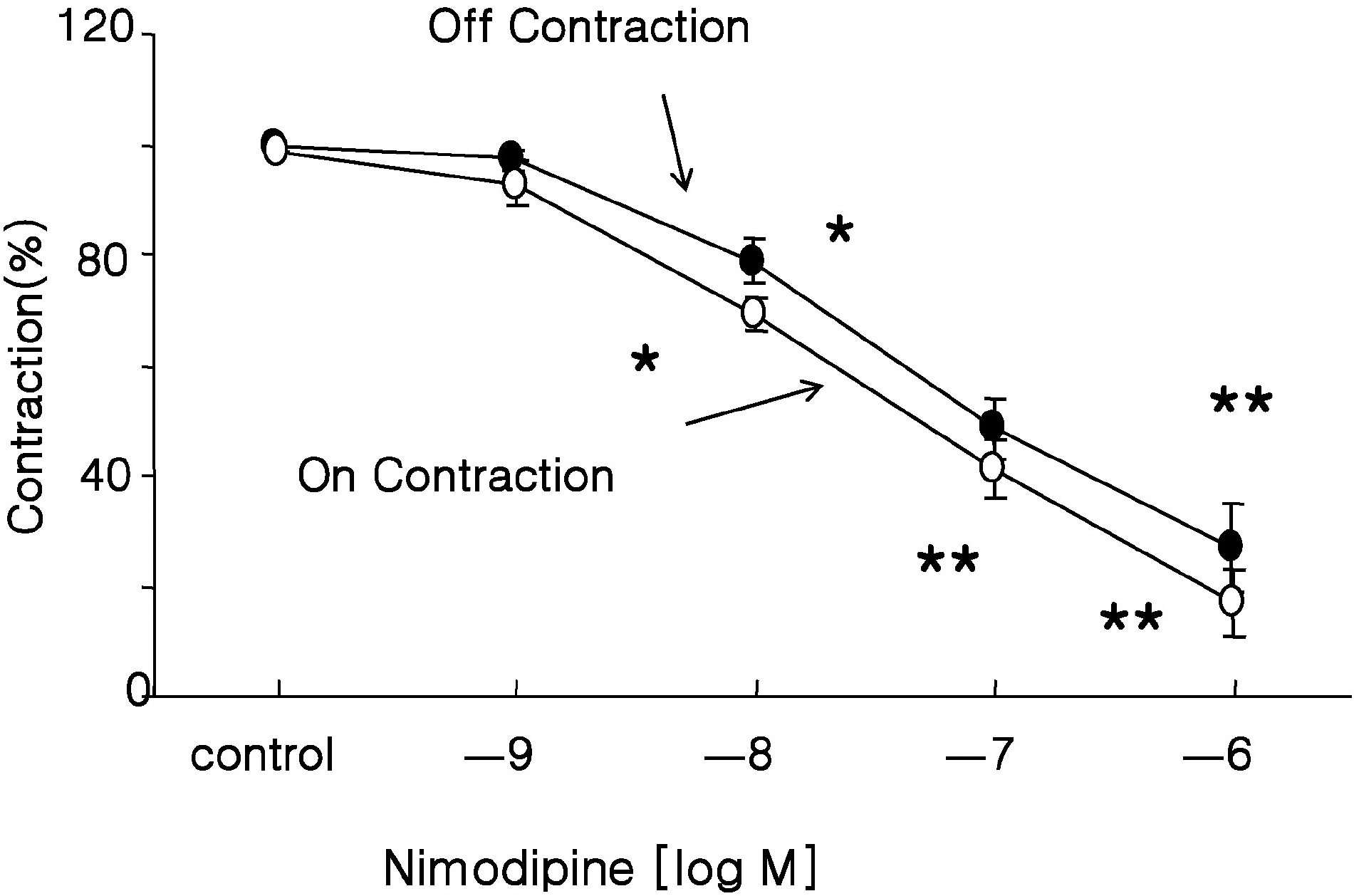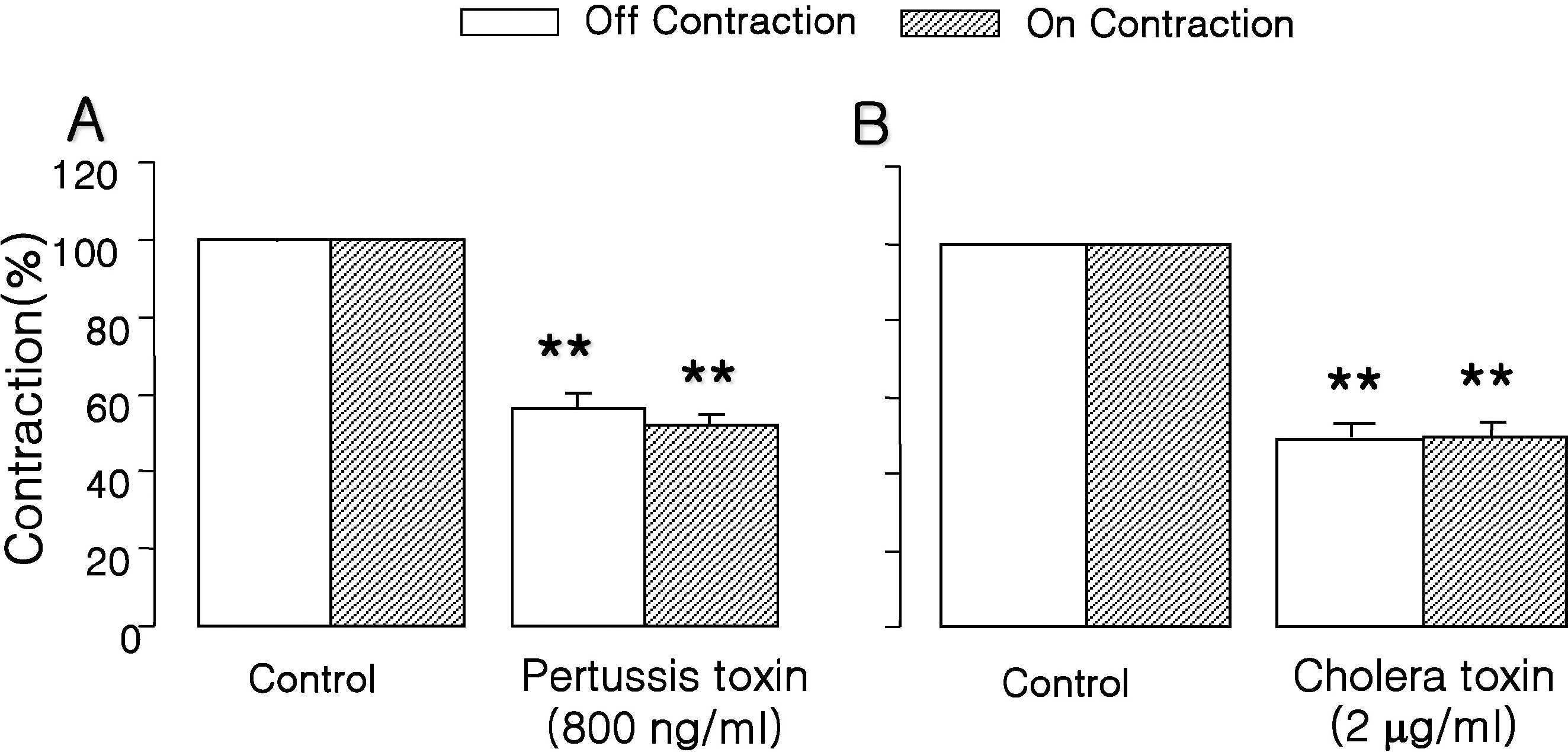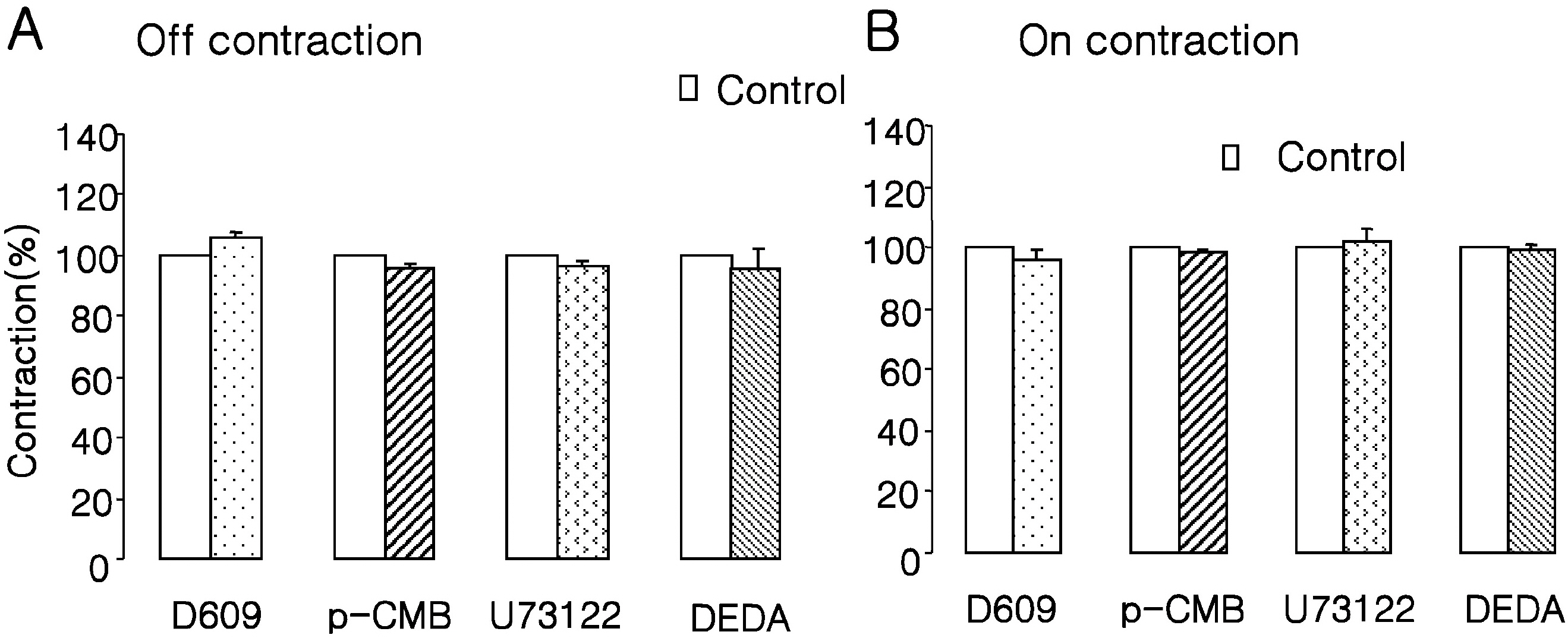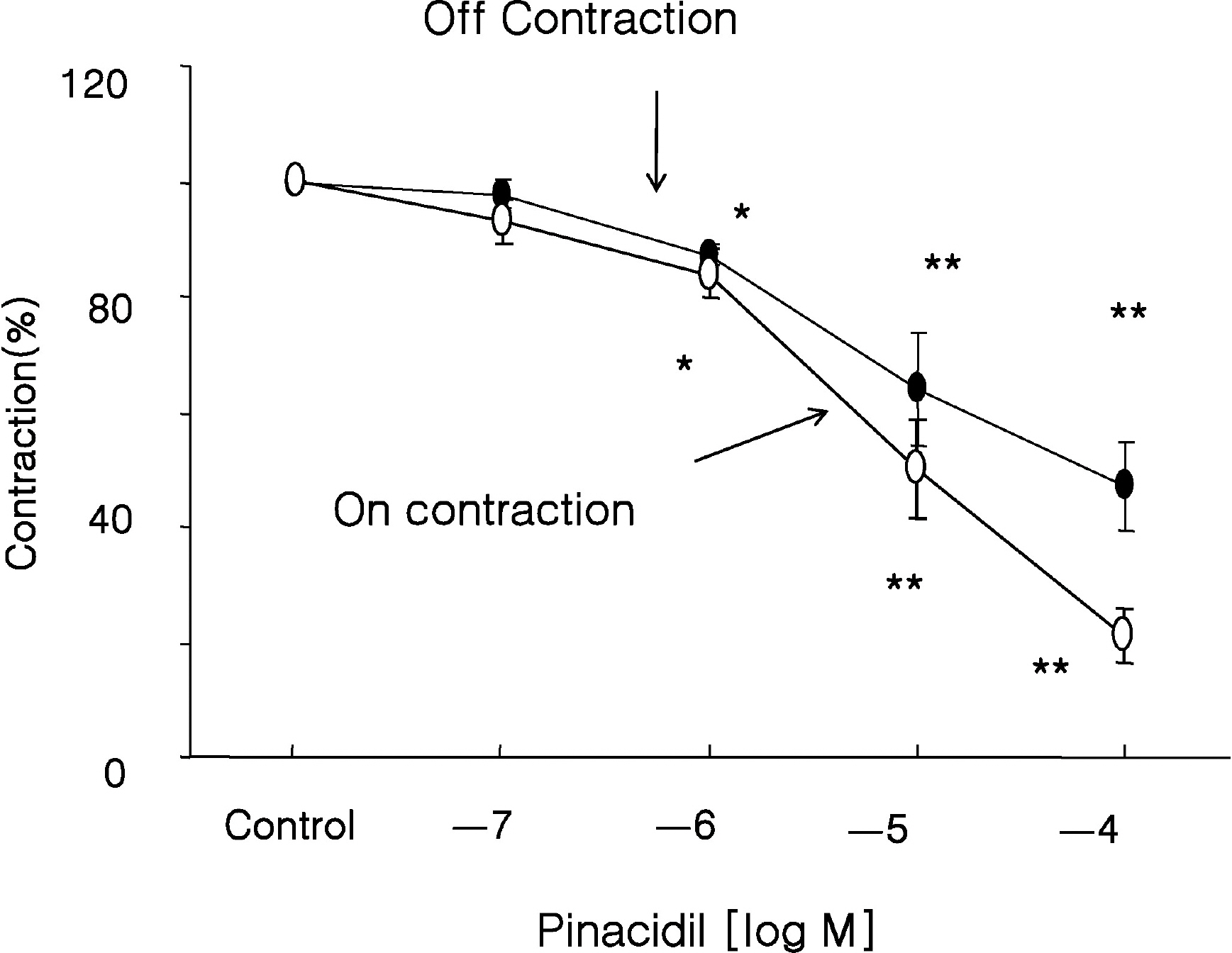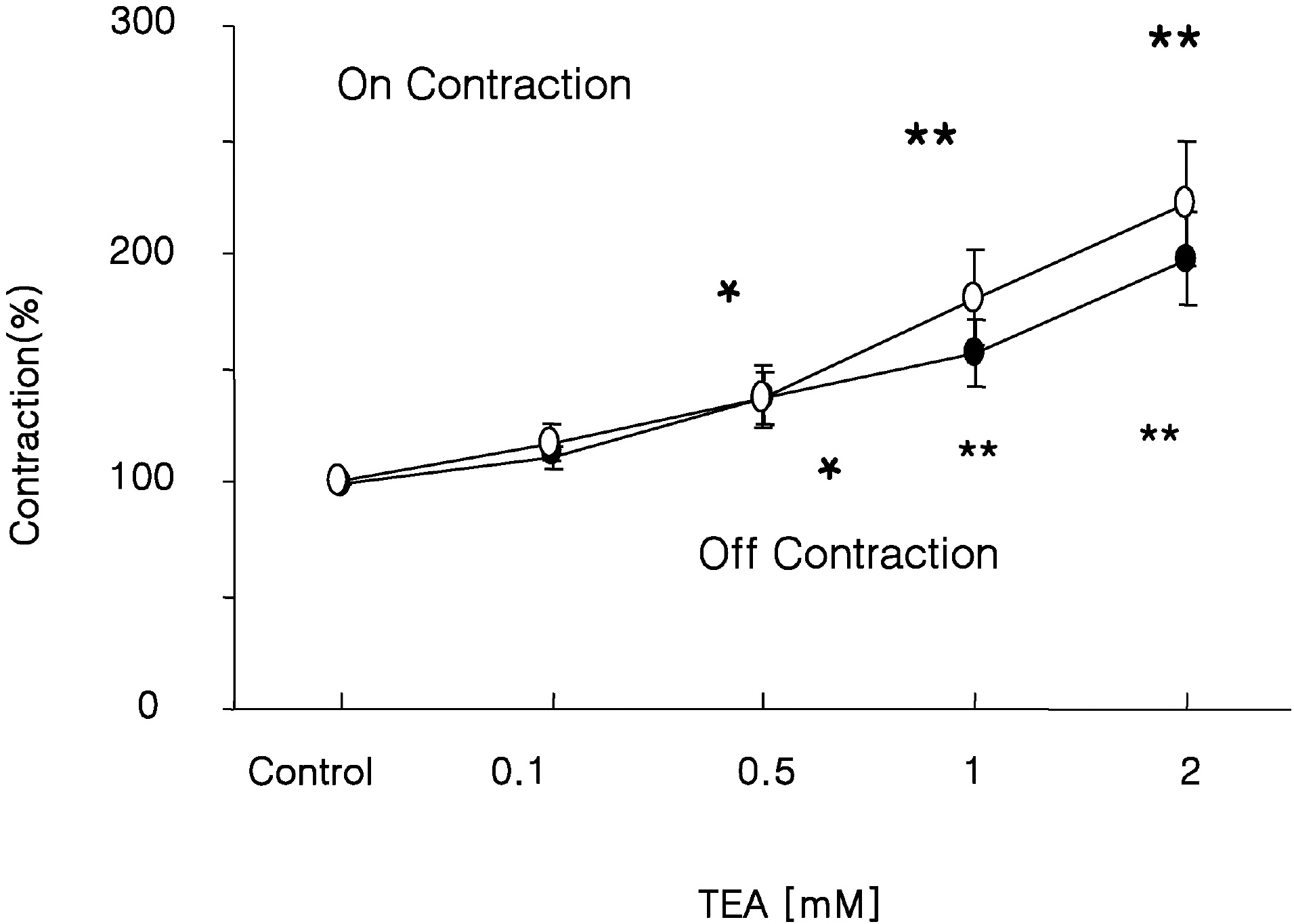Korean J Physiol Pharmacol.
2009 Oct;13(5):393-400. 10.4196/kjpp.2009.13.5.393.
The Influences of G Proteins, Ca2+, and K+ Channels on Electrical Field Stimulation in Cat Esophageal Smooth Muscle
- Affiliations
-
- 1College of Pharmacy, Chung-Ang University, Seoul 156-756, Korea. udsohn@cau.ac.kr
- 2School of Medicine, Chung-Ang University, Seoul 156-756, Korea.
- 3School of Medicine, Kyungpook National University, Daegu 700-422, Korea.
- KMID: 1982574
- DOI: http://doi.org/10.4196/kjpp.2009.13.5.393
Abstract
- NO released by myenteric neurons controls the off contraction induced by electrical field stimulation (EFS) in distal esophageal smooth muscle, but in the presence of nitric oxide synthase (NOS) inhibitor, L-NAME, contraction by EFS occurs at the same time. The authors investigated the intracellular signaling pathways related with G protein and ionic channel EFS-induced contraction using cat esophageal muscles. EFS-induced contractions were significantly suppressed by tetrodotoxin (1 micrometer) and atropine (1 micrometer). Furthermore, nimodipine inhibited both on and off contractions by EFS in a concentration dependent meaner. The characteristics of 'on' and 'off' contraction and the effects of G-proteins, phospholipase, and K+ channel on EFS-induced contraction in smooth muscle were also investigated. Pertussis toxin (PTX, a Gi inactivator) attenuated both EFS-induced contractions. Cholera toxin (CTX, Gs inactivator) also decreased the amplitudes of EFS-induced off and on contractions. However, phospholipase inhibitors did not affect these contractions. Pinacidil (a K+ channel opener) decreased these contractions, and tetraethylammonium (TEA, K+ Ca channel blocker) increased them. These results suggest that EFS-induced on and off contractions can be mediated by the activations Gi or Gs proteins, and that L-type Ca2+ channel may be activated by G-protein alpha subunits. Furthermore, K+ Ca-channel involve in the depolarization of esophageal smooth muscle. Further studies are required to characterize the physiological regulation of Ca2+ channel and to investigate the effects of other K+ channels on EFS-induced on and off contractions.
Keyword
MeSH Terms
-
Animals
Atropine
Cats
Cholera Toxin
Contracts
GTP-Binding Protein alpha Subunits
GTP-Binding Proteins
Ion Channels
Muscle, Smooth
Muscles
Neurons
NG-Nitroarginine Methyl Ester
Nimodipine
Nitric Oxide Synthase
Pertussis Toxin
Phospholipases
Pinacidil
Proteins
Tetraethylammonium
Tetrodotoxin
Atropine
Cholera Toxin
GTP-Binding Protein alpha Subunits
GTP-Binding Proteins
Ion Channels
NG-Nitroarginine Methyl Ester
Nimodipine
Nitric Oxide Synthase
Pertussis Toxin
Phospholipases
Pinacidil
Proteins
Tetraethylammonium
Tetrodotoxin
Figure
Reference
-
References
Archer SL., Huang JM., Hampl V., Nelson DP., Shultz PJ., Weir EK. Nitric oxide and cGMP cause vasorelaxation by activation of a charybdotoxin-sensitive K channel by cGMP-dependent protein kinase. Proc Natl Acad Sci USA. 91:7583–7587. 1994.
ArticleBehar J., Guenard V., Walsh JH., Biancani P. VIP and acetylcholine: neurotransmitters in esophageal circular smooth muscle. Am J Physiol. 257:G380–385. 1989.
ArticleBerridge MJ. Inositol trisphosphate and calcium signalling. Nature. 361:315–325. 1993.
ArticleBiancani P., Hillemeier C., Bitar KN., Makhlouf GM. Contraction mediated by Ca2+ influx in esophageal muscle and by Ca2+ release in the LES. Am J Physiol. 253:G760–766. 1987.Biancani P., Walsh JH., Behar J. Vasoactive intestinal polypeptide. A neurotransmitter for lower esophageal sphincter relaxation. J Clin Invest. 73:963–967. 1984.
ArticleBolotina VM., Najibi S., Palacino JJ., Pagano PJ., Cohen RA. Nitric oxide directly activates calcium-dependent potassium channels in vascular smooth muscle. Nature. 368:850–853. 1994.
ArticleCarabelli V., Hernandez-Guijo JM., Baldelli P., Carbone E. Direct autocrine inhibition and cAMP-dependent potentiation of single L-type Ca2+ channels in bovine chromaffin cells. J Physiol. 532:73–90. 2001.Casey PJ., Gilman AG. G protein involvement in receptor-effector coupling. J Biol Chem. 263:2577–2580. 1988.
ArticleCayabyab FS., Daniel EE. K+ channel opening mediates hyper-polarizations by nitric oxide donors and IJPs in opossum esophagus. Am J Physiol. 268:G831–842. 1995.Christinck F., Jury J., Cayabyab F., Daniel EE. Nitric oxide may be the final mediator of nonadrenergic, noncholinergic inhibitory junction potentials in the gut. Can J Physiol Pharmacol. 69:1448–1458. 1991.
ArticleConklin JL., Du C. Guanylate cyclase inhibitors: effect on inhibitory junction potentials in esophageal smooth muscle. Am J Physiol. 263:G87–90. 1992.
ArticleConklin JL., Du C., Murray JA., Bates JN. Characterization and mediation of inhibitory junction potentials from opossum lower esophageal sphincter. Gastroenterology. 104:1439–1444. 1993.
ArticleCrist J., Gidda JS., Goyal RK. Characteristics of ‘on’ and ‘off’ contractions in esophageal circular muscle. in vitro. Am J Physiol. 246:G137–144. 1984.Dalziel HH., Thornbury KD., Ward SM., Sanders KM. Involvement of nitric oxide synthetic pathway in inhibitory junction potentials in canine proximal colon. Am J Physiol. 260:G789–792. 1991.
ArticleDascal N. Ion-channel regulation by G proteins. Trends Endocrinol Metab. 12:391–398. 2001.
ArticleDiamant NE. Physiology of esophageal motor function. Gastroenterol Clin North Am. 18:179–194. 1989.
ArticleDu C., Murray J., Bates JN., Conklin JL. Nitric oxide: mediator of NANC hyperpolarization of opossum esophageal smooth muscle. Am J Physiol. 261:G1012–1016. 1991.
ArticleFleischmann BK., Murray RK., Kotlikoff MI. Voltage window for sustained elevation of cytosolic calcium in smooth muscle cells. Proc Natl Acad Sci USA. 91:11914–11918. 1994.
ArticleGoyal RK., Rattan S., Said SI. VIP as a possible neurotransmitter of non-cholinergic non-adrenergic inhibitory neurones. Nature. 288:378–380. 1980.
ArticleHillemeier C., Bitar KN., Marshall JM., Biancani P. Intracellular pathways for contraction in gastroesophageal smooth muscle cells. Am J Physiol. 260:G770–775. 1991.
ArticleIvanina T., Blumenstein Y., Shistik E., Barzilai R., Dascal N. Modulation of L-type Ca2+ channels by gbeta gamma and calmodulin via interactions with N and C termini of alpha 1C. J Biol Chem. 275:39846–39854. 2000.Jessell TM., Kandel ER. Synaptic transmission: a bidirectional and self-modifiable form of cell-cell communication. Cell. 72(Suppl):1–30. 1993.
ArticleKelly RB. Storage and release of neurotransmitters. Cell. 72(Suppl):43–53. 1993.
ArticleMiyoshi H., Nakaya Y. Endotoxin-induced nonendothelial nitric oxide activates the Ca2+-activated K+ channel in cultured vascular smooth muscle cells. J Mol Cell Cardiol. 26:1487–1495. 1994.Murray J., Du C., Ledlow A., Bates JN., Conklin JL. Nitric oxide: mediator of nonadrenergic noncholinergic responses of opossum esophageal muscle. Am J Physiol. 261:G401–406. 1991.
ArticleMurray JA., Shibata EF., Buresh TL., Picken H., O'Meara BW., Conklin JL. Nitric oxide modulates a calcium-activated potassium current in muscle cells from opossum esophagus. Am J Physiol. 269:G606–612. 1995.
ArticlePark SY., Shin CY., Song HJ., Min YS., La Hyen O., Lee JW., Kim do Y., Je HD., Sohn UD. Electrically stimulated relaxation is not mediated by GABA in cat lower esophageal sphincter muscle. Arch Pharm Res. 29:400–404. 2006.
ArticlePark SY., Song HJ., Sohn UD. Participation of Rho-associated kinase in electrical stimulated and acetylcholine-induced contraction of feline esophageal smooth muscle. Eur J Pharmacol. 607:220–225. 2009.
ArticlePope CE 2nd. The esophagus for the nonesophagologist. Am J Med. 103:19S–22S. 1997.
ArticleRattan S., Chakder S. Role of nitric oxide as a mediator of internal anal sphincter relaxation. Am J Physiol. 262:G107–112. 1992.
ArticleRoman C. Nervous control of esophageal peristalsis. J Physiol (Paris). 58:79–108. 1966.Roman C., Car A. Esophageal contractions produced by stimulation of the vagus or of the medulla oblongata. J Physiol (Paris). 59:377–398. 1967.Sato K., Sanders KM., Gerthoffer WT., Publicover NG. Sources of calcium utilized in cholinergic responses in canine colonic smooth muscle. Am J Physiol. 267:C1666–1673. 1994.
ArticleSims SM., Jiao Y., Preiksaitis HG. Regulation of intracellular calcium in human esophageal smooth muscles. Am J Physiol. 273:C1679–1689. 1997.Sohn UD., Chiu TT., Bitar KN., Hillemeier C., Behar J., Biancani P. Calcium requirements for acetylcholine-induced contraction of cat esophageal circular muscle cells. Am J Physiol. 266:G330–338. 1994.
ArticleSohn UD., Han B., Tashjian AH Jr., Behar J., Biancani P. Agonist-independent, muscle-type-specific signal transduction pathways in cat esophageal and lower esophageal sphincter circular smooth muscle. J Pharmacol Exp Ther. 273:482–491. 1995.Sohn UD., Harnett KM., De Petris G., Behar J., Biancani P. Distinct muscarinic receptors, G proteins and phospholipases in esophageal and lower esophageal sphincter circular muscle. J Pharmacol Exp Ther. 267:1205–1214. 1993.Somlyo AP., Somlyo AV. Signal transduction and regulation in smooth muscle. Nature. 372:231–236. 1994.
ArticleTottrup A., Svane D., Forman A. Nitric oxide mediating NANC inhibition in opossum lower esophageal sphincter. Am J Physiol. 260:G385–389. 1991.
ArticleUnwin N. Neurotransmitter action: opening of ligand-gated ion channels. Cell. 72(Suppl):31–41. 1993.
Articlevan Breemen C., Saida K. Cellular mechanisms regulating [Ca2+]i smooth muscle. Annu Rev Physiol. 51:315–329. 1989.Viard P., Exner T., Maier U., Mironneau J., Nurnberg B., Macrez N. Gbetagamma dimers stimulate vascular L-type Ca2+ channels via phosphoinositide 3-kinase. Faseb J. 13:685–694. 1999.Wade GR., Laurier LG., Preiksaitis HG., Sims SM. Delayed rectifier and Ca2+-dependent K+ currents in human esophagus: roles in regulating muscle contraction. Am J Physiol. 277:G885–895. 1999.Weisbrodt NW., Christensen J. Gradients of contractions in the opossum esophagus. Gastroenterology. 62:1159–1166. 1972.
ArticleYamato S., Saha JK., Goyal RK. Role of nitric oxide in lower esophageal sphincter relaxation to swallowing. Life Sci. 50:1263–1272. 1992.
ArticleYang SJ., An JY., Shim JO., Park CH., Huh IH., Sohn UD. The mechanism of contraction by 2-chloroadenosine in cat detrusor muscle cells. J Urol. 163:652–658. 2000.
ArticleZhong J., Dessauer CW., Keef KD., Hume JR. Regulation of L-type Ca2+ channels in rabbit portal vein by G protein alphas and betagamma subunits. J Physiol. 517:109–120. 1999.
- Full Text Links
- Actions
-
Cited
- CITED
-
- Close
- Share
- Similar articles
-
- MLCK and PKC Involvements via Gi and Rho A Protein in Contraction by the Electrical Field Stimulation in Feline Esophageal Smooth Muscle
- Effects of Fluoxetine on Potassium Channels in Cat Gastric Smooth Muscle Cells
- P2X and P2Y Receptors Mediate Contraction Induced by Electrical Field Stimulation in Feline Esophageal Smooth Muscle
- The Effect Erythrocyte lysate on Intracellular Calcium Concentration and the Potassium Channel in Cerebral Vasular Smooth Muscle Cells
- The alteration of Ca2+-activated K+ channels in coronary arterial smooth muscle cells isolated from isoproterenol-induced cardiac hypertrophy in rabbit



